
ABSTRACT
A set of experiments related to Fluid Mechanics concepts constitute an obligatory course in the undergraduate Chemical Engineering Program at the State University of Campinas-Brazil. In this course, the students are divided into groups. In each class that precedes a determined experiment, a group meets with the instructor. It is recommended that each group prepares for both theoretical and experimental concerning aspects the subject being treated. In this class, in a preliminary step, students are stimulated to say any word, pertinent or not, to subject in question: brainstorming. In a second step, words are screened leading to the construction of a cause-effect diagram. In this diagram each word is associated with a theoretical-experimental context. The interpretation of these words leads to the comprehension of the subject being studied as well as the identification of errors that can lead to failure of the experiment. The objective this method is to stimulate the student to be creative and to develop group work as well as strengthening the inherent concepts of the analysed phenomena.
INTRODUCTION
The undergraduate Chemical Engineering University of Unicamp present five labs. Among them is EQ 601: Chemical Engineering Lab I, comprising five experiments as show in the Picture 1.
Picture 1- EQ 601 Experiments.
| 01- Reology
02- Reynolds Experiment 03- Non-newtonian fluid flow 04- Flow measurement 05- Head loss in accidents |
In the beginning of each school period the dynamic work of EQ 601 is set up. The activities chonogram is defined as well as the evaluation criteria and the students groups, that composed of five integrants. There would be fifteen groups in three teams an average. The teams perform the experiments, in turns, as indicated in the Picture 1. To each experiment are associated three basic stage:
a- Debate of the experiment theory and practice of the experiment (in a class prior that one of experimental activity).
b- Delivery of a preliminary report concerning to the experiment debate and data getting (in the class in which the experiment has bee performed).
c-Delivery of a conclusive report (in a class further the experiment and similar to the debate of the next experiment.
The goals to be reached are: desinhibition, initiative, creativity, ability of work group and critical sense.
THE METHODOLOGY DYNAMIC
The proposed methodology aims to the class prior the experiment activity, that is, the debate class or simply debate. So, it is necessary:
1) Physical space: A class whith 06 persons in it.
2) Materials: Chalk and board.
3) Components: Group of 03 or 05 persons.
4) Time: 50 or 60 minutes.
Brainstorming
The brainstorming is employed to generate ideas to support the creativity development. Such as technique is used for some kinds of meeting to find out general solutions.
It is required as objective, a target to be reached when brainstorming is intended to be applied. The brainstorming could be the arch, and the ideas could be arrows. The target has to be hit, independent of the amount and the quality of the arrows to be thrown. Any sort of arrows has to be cast out: big, short, thin, large, straight or bent ones. Those are the contents inside the brainstorming; they can support the great ideas we have in mind to make possible to reach any goals.
That stage of the brainstorming intend to present a methodology to promote an open debate about any experiment. First, the student spells words that comes in mind, related or not to the subjects to be discussed. The words have to be spelt like thrown arrows.
With the objective of stirring up the partnership of the group and turning it up the matter to be discussed, the following procedure shall be met.
1) The group shall lead the debate, by having in mind which experiment will be discussed.
It's normal the group receives and does not supply data to the debate. The group members become shy and be afraid of taking lead. Cross talks arise, in the proportion a non conventional class is realised. Disappointment is generated, for the teacher is expected to preview concepts linked to the experiment or he can inform the experiment procedure to be developed during next class. It is like a mute pictures, or as interrogative over the group heads.

2) The teacher insists the initiative comes from the group, that leads the debate.
Notice that in the stage the inhibition keeps on going, and the group is not interested to debate the matter. Picture 2 still show that stage.
3) The teacher incites each member to tell any word even that is not set in the experiment context.
In this stage, the structured brainstorming is used, in which each member supplies a word (idea) each turn or postpones it till next turn. Or even he can employ non-structured brainstorming in which the member may express aleatory. The choice of the technique depends upon the interest of the group to participate. The shy member should not be pressed to participate (structured brainstorming) and the extroverted should not surpass the debate (non-structured brainstorming). In any method, it is supposed an open and dynamic debate in which any word or idea may be criticises even it seems absurd or ridiculous.
Here, little by little, the students participate. If taking the Reynolds experiment, as an example, we have a verbal situation like the one presented in the Picture 3.
Picture 3- Brainstorming: to thrown the arrows.
| I don't know!
It doesn't matter! Anything I'm sleepy! I'm thirsty Water Flow Mercury Venus Laminar regime Equipment |
Girlfriend
critical Reynolds Beer Bomb Bombs Pumps Turbulent regime Disorder I already know! Piping Stress |
Experiments
Valves Tubes Mechanic Bag Transport Movement Data Computer Theory Joy |
4) The teacher list up the words on a board.
5) The teacher asks the person who has spelt any word to justify it, trying to situate it in experiment context. Here it is possible all the group participation to help and fill the fellow's answer.
In this stage, the group is not shy and integrated in the method spirit. As the words have been associated to the experiment, the group begins to identify the inherent theoretic context. It is observed also interpersonal relationship words, group work, good-humour, work disposition and so on.
6) The group of students analyses and filters critically the words linked to the experiment.
In this stage it is observed the debate is directed to the experiment, and it can be explored
mentally and fully.
The Picture 4 shows the brainstorming filtered word presented in the Picture 3.
Picture 4- Pertinents words arose from the brainstorming to the Reynolds experiment.
| Flow
Laminar regime Equipment |
critical Reynolds
Pump Turbulent regime |
Valves
Tubes |
The brainstorming stage doesn't end up the debate. It allows to break the ice between the students and the experiment, as well as between students and the teacher. In the end of the stage, the environment will be pleasant in which it is discussed the matter pertinent to the experiment that will be revigorated by the students development. The student may remember some concepts that have been forgotten.
Notwithstanding it seems a disorder, the brainstorming is not a lack of control. It is a mind activity. The teacher is a guide of ideas and not a keeps of rules.
What to do with the brainstorming? That technique allows the students to be inhibit. It has allowed the theoretic and experimental of the experiment to be performed. Otherwise, how best the students may perform that experiment, without mistakes? Which are the factors that will be taken into consideration to the best experiment.
Cause-Effect diagram
The Cause-Effect diagram intends to present the relation between the quality characteristic and the factors that have been taken to that characteristic.
Presently, we have the theoretic debate of the experiment, and not how to do it really. It has to be performed correctly. Therefore, after the stage six, the global context shall be defined. The global context is the experiment itself. That is has to be done. As an example, here is the Reynolds experiment, in Figure 1.
1- Reynolds experiment
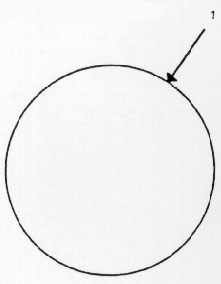
Figure 1- Global context (Reynolds experiment).
In the Reynolds experiment, as an illustration, the words related to the Picture 3 have been told. In that picture there are n-subcontexts (words) inside the Reynolds experiment (global context). That is, there are n-subcontext in the global context, see Figure 2.
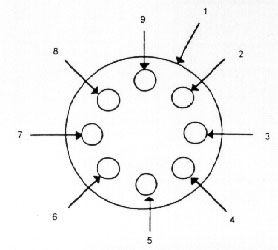 1- Reynolds experiment
1- Reynolds experiment
2- Flow
3- Laminar regime
4- critical Reynolds
5- Turbulent regime
6- Equipment
7- Pump
8- Tubes
9- Valves
Figure 2- N subcontexts in the global context.
In the example of Reynolds experiment, a theoretic subcontext (flow) and an experimental (equipment) have been identified. Inside the subcontext flow there are the subcontexts (words) Turbulent regime and Laminar regime and inside that subcontext the critical Reynolds (that is defined when the regime stops being Laminar). In the subcontext equipment are found the subcontexts pump, valve, tubes. Those subcontexts are presented in the Figure 3.
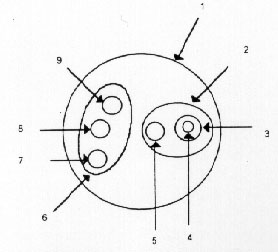 1- Reynolds experiment
1- Reynolds experiment
2- Flow
3- Laminar regime
4- critical Reynolds
5- Turbulent regime
6- Equipment
7- Pump
8- Tubes
9- Valves
Figure 3- Subcontexts that characterise the global context.
There is an interconnection between the several subcontexts related to the condition type: What valve (word) has been classified in the equipment (word)? Which is the relationship whit the experiment? Notice the relationship in the shapes:
To subcontext equipment:
valve -----> equipment ------> Reynolds experiment
To subcontext flow:
critical Reynolds -----> Laminar regime -----> flow -----> Reynolds experiment
Those relationships may be related by means of the following diagram
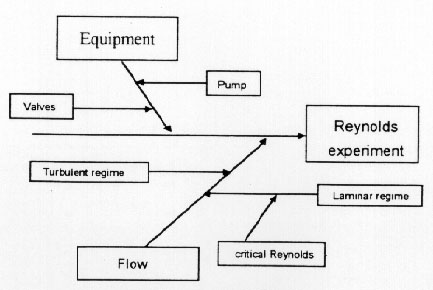
Diagram 1- Cause-Effect diagram.
The diagram 1 is known as Cause-Effect or Fish Column. In the end of the main column (the fish head) Effect is found. In the side columns the Causes are found. Those Causes become Effects as the side columns come forth. It is emphasised a wrong interpretation of a word (subcontext) may make wrong all the diagram, implicating the analysis of the global context (of the experiment specifically). Here the teacher/facilitator direct the groups attention to the lack of knowledge that may bring a theoretic or a experimental wrong.
After that explanation we can go back to the steps of the methodology proposed in this paper, as follows:
8) The group identifies the similar words.
9) Global context and subcontexts are identified.
10) Cause-Effect diagram is brought forth.
11) The teacher, now facilitator, emphasises the importance of the words.
12) Another brainstorming is performed.
Noticed the group names personal words: correct readings, correct calculus, group work, good-humour, disposition to the work among others.
13) Cause-Effect diagram structure.
The facilitator requires the group to develop fictitious experimental data and to simulate the experiment to reach 100% per cent of efficiency. Got the results, the team shall perform the preliminary report, comprising: theoretical information only about the experiment, correct experimental procedure, correct calculus and Cause-Effect diagram that allows the group to identify possible failures during and after the performance of the experiment.
FINALS COMMENTS
In possession of the preliminary report of 15 groups, in the average of 5 students, the following Cause-Effect diagram has been got to the experiments 02 and 03 of the Picture 1, for the efficiency of 100% per cent of the performed experimental.
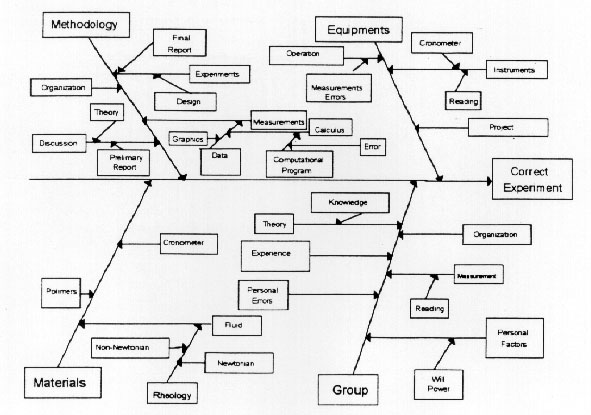
Diagram 2- The GEMM diagram.
In the Diagram 2, the main causes (words) are Group, Equipment, Methodology and Materials, that are resumed as GEMM. For each Cause there are other and so on. The efficiency of the experiment is not resumed in the recognition in this diagram, but they are enough for a good development of the experimental activity.
The students are expected to develop real hope in the experiment conduction. They are also supposed to develop the critical sense for to analyse: the equipment, the data to be got, the treatment of those data, the results and self-analysis, understanding that correct experiment is not necessarily, whose results had been suitable to that had been found in the literature, but how the experiment had been developed.
So, we believe the students are able, beside working in group, to analyse contrary situations, initiative and creativity to suggest improvements.
REFERENCES
Brassard, M. "Quality: tools for a continuous improvement" (in portuguese), Qualitymark Editora, Rio de Janeiro, s/d.
Cremasco, S.B.R. and Cremasco, M.A., "The feasibility of employing group dynamics on a theoretical course of engineering: a experience at the Chemical Engineering School at Unicamp", Proceedings of XXII Congresso Brasileiro de Ensino de Engenharia (in portuguese), pp. 458-463, Porto Alegre, Brasil, 1994.
Cremasco, M.A. and Cremasco, S.B.R., "Chemical Engineering Laboratory: Development of a teaching methodology ", Proceedings of IX Congreso Nacional de Ingenieria Química (in spanish), v.2, pp.584-589, Valparaiso, Chile, 1996.
Kume, H., "Statistics methods to improve quality" (in portuguese), Editora Gente, São Paulo, 1993.